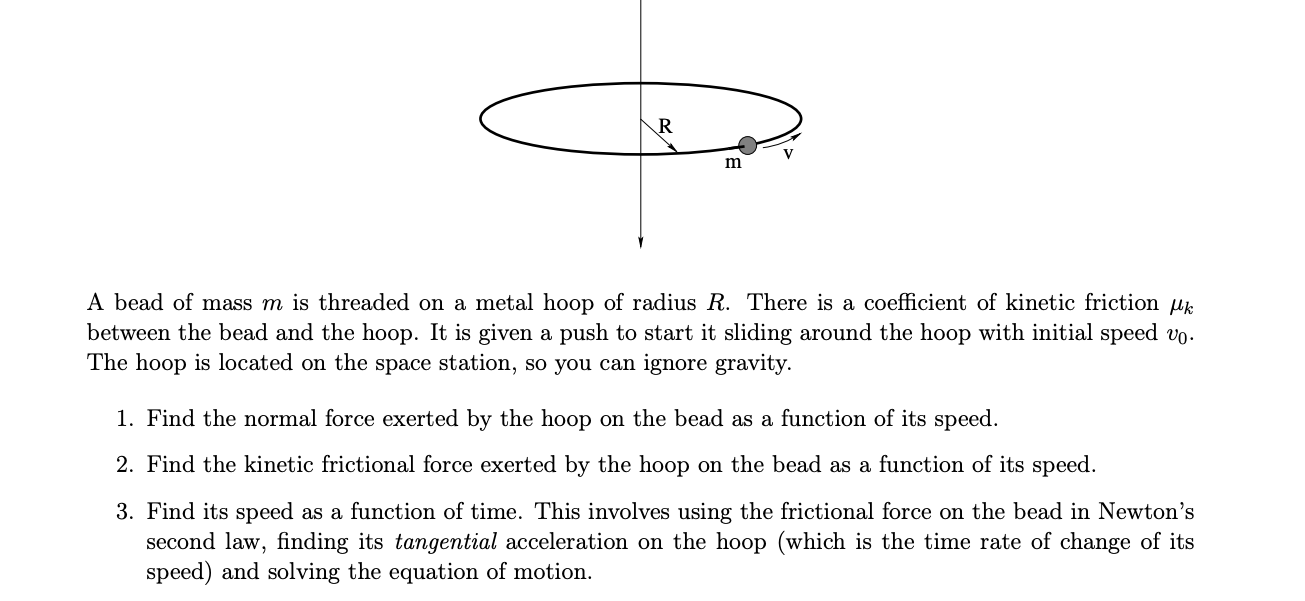A bead of mass m is threaded on a metal hoop of radius R. There is a coefficient of kinetic friction µk between the bead and the hoop. It is given a push to start it sliding around the hoop with initial speed vo. The hoop is located on the space station, so you can ignore gravity. 1. Find the normal force exerted by the hoop on the bead as a function of its speed. 2. Find the kinetic frictional force exerted by the hoop on the bead as a function of its speed. 3. Find its speed as a function of time. This involves using the frictional force on the bead in Newton's second law, finding its tangential acceleration on the hoop (which is the time rate of change of its speed) and solving the equation of motion
A bead of mass m is threaded on a metal hoop of radius R. There is a coefficient of kinetic friction µk between the bead and the hoop. It is given a push to start it sliding around the hoop with initial speed vo. The hoop is located on the space station, so you can ignore gravity. 1. Find the normal force exerted by the hoop on the bead as a function of its speed. 2. Find the kinetic frictional force exerted by the hoop on the bead as a function of its speed. 3. Find its speed as a function of time. This involves using the frictional force on the bead in Newton's second law, finding its tangential acceleration on the hoop (which is the time rate of change of its speed) and solving the equation of motion
Physics for Scientists and Engineers: Foundations and Connections
1st Edition
ISBN:9781133939146
Author:Katz, Debora M.
Publisher:Katz, Debora M.
Chapter5: Newton's Laws Of Motion
Section: Chapter Questions
Problem 74PQ: Starting from rest, a rectangular toy block with mass 300 g slides in 1.30 s all the way across a...
Related questions
Question

Transcribed Image Text:A bead of mass m is threaded on a metal hoop of radius R. There is a coefficient of kinetic friction µk
between the bead and the hoop. It is given a push to start it sliding around the hoop with initial speed vo.
The hoop is located on the space station, so you can ignore gravity.
1. Find the normal force exerted by the hoop on the bead as a function of its speed.
2. Find the kinetic frictional force exerted by the hoop on the bead as a function of its speed.
3. Find its speed as a function of time. This involves using the frictional force on the bead in Newton's
second law, finding its tangential acceleration on the hoop (which is the time rate of change of its
speed) and solving the equation of motion
Expert Solution
This question has been solved!
Explore an expertly crafted, step-by-step solution for a thorough understanding of key concepts.
This is a popular solution!
Trending now
This is a popular solution!
Step by step
Solved in 2 steps with 2 images

Knowledge Booster
Learn more about
Need a deep-dive on the concept behind this application? Look no further. Learn more about this topic, physics and related others by exploring similar questions and additional content below.Recommended textbooks for you

Physics for Scientists and Engineers: Foundations…
Physics
ISBN:
9781133939146
Author:
Katz, Debora M.
Publisher:
Cengage Learning

University Physics Volume 1
Physics
ISBN:
9781938168277
Author:
William Moebs, Samuel J. Ling, Jeff Sanny
Publisher:
OpenStax - Rice University

Physics for Scientists and Engineers: Foundations…
Physics
ISBN:
9781133939146
Author:
Katz, Debora M.
Publisher:
Cengage Learning

University Physics Volume 1
Physics
ISBN:
9781938168277
Author:
William Moebs, Samuel J. Ling, Jeff Sanny
Publisher:
OpenStax - Rice University